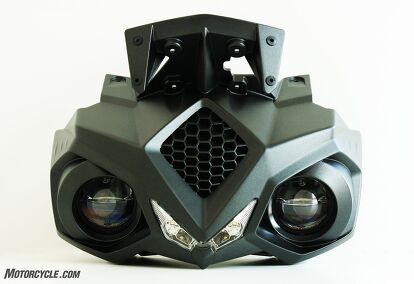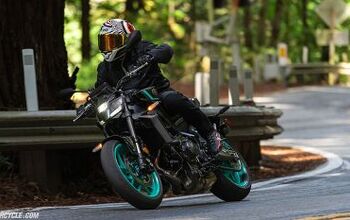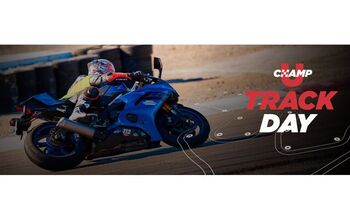Energica: A Year To Remember (And It's Only Half Over)

A small motorcycle company, despite adversity, steps onto the world stage
Energica expected the eyes of the world to be on them in 2019, but not in the way that they were on March 14. That’s the day that the Moto-E paddock burnt to the ground in Jerez as the result of a short in the charging infrastructure in the temporary building, taking the entire 18-bike fleet of Energica race bikes destined for the fledgling electric grand-prix series with it. I can’t imagine what the mood was like around the Energica offices the morning after the fire. Everyone watching the series knows that Energica isn’t a huge monolith that can crank out a seemingly endless line of machinery at the flip of the switch. So, what’s a little company that’s managed to get into the international big-leagues going to do? Everything it can, I suspect. Fortunately, its parent company knows a thing or two about quick turn around.
Energica is part of the CRP Group, which has made its name as part of the aerospace industry, a defense supplier, and Formula 1 parts developer. CRP traces its origins to a machine shop some 50 years ago, and now it is a leader in what used to be called rapid prototyping technology. Many may call it 3-D printing, but CRP would prefer that we call their process additive manufacturing. While additive manufacturing may be the newest area of CRP’s expertise, it has also kept up with the machining world, and their facilities feature 15 state-of-the-art five-axis mills among other machinery. Therefore it should come as no surprise that many of the parts on Energica’s motorcycles are machined or printed in house. Additionally, having access to these technologies makes it possible for the company to develop bikes quite rapidly. For example, Energica signed the Moto-E contract with Dorna in December 2017, and by May 2018, the first prototypes were being tested at Le Mans.
Admittedly, these were not ground-up prototypes; they were based on the Energica Ego street bike. Still, every aspect of the Ego had to be massaged in the transition to international-level racing. “We started from a very good base. We started from the Ego, and this gave us a big advantage.” says Giampiero Testoni, Energica CTO. “But then we needed more range, we needed more power, we needed more speed. Then we need more brakes. Then we need better suspension and better handling.” Each change necessitated other changes. For example, Energica began with an all-new battery pack, which then required completely new electronics to manage the increased power.
Producing a racing motorcycle has a completely different set of goals from building one for the street. Consumer products need to be reliable and safe in a wide range of conditions. Street riders don’t have a cadre of dedicated mechanics to make sure everything is performing up to spec, and replacing the parts that aren’t, after each ride, like the international race teams do. This is where Energica’s relationship with CRP comes into play. Says Testoni, “We want to do something new, in one week, we do it. We are very fast in that.” However, despite all the changes made in the transition from the street to the track, the roots of the racebike can still be easily traced back to the Ego: “We tested more brakes, more power, more speed, stronger frame and swingarm. Strongly different, but it’s completely derived. Dynamics and geometry are the same.”
What has the potential to make the Moto-E championship so interesting is that Energica is supplying all of the bikes to the teams, meaning the bikes are essentially identical and the teams are limited in the changes they can make in their loaner motorcycle. According to Testoni, “Just suspension, gearing, and then settings for the rider. Nothing more. The rider can change the throttle response with different maps. Other things like engine braking, they can set up the levels of this.” The challenge for the teams is to set their bike up to suit their rider as best as they can within these parameters. The rest is up to the riders.
Since Energica is a small company and is providing 18 motorcycles for the Moto-E series, even before the Jerez fire, the task must have been testing the capabilities of the company. What’s in it for Energica? Is it just the fame of being the sole provider of Moto-E’s machinery for three years? Livia Cevolini, CEO Energica, explains: “We have the best riders in the world – for three years – to test only for us. No one else has this. [Other manufacturers] can have one rider testing every day, but I have 18 different riders, everyone with different needs and different weight, different everything. I have their data. A lot of data. A lot of kilometers on the race track, and of course, we will continue on the road with our riders. But that is something that everyone can do. This is something that we will be the only one for three years. It’s a huge investment for us, but I think that it is the best that we could do for our customers.”
Naturally, Cevolini keeps her company’s cards close to the chest when asked about what the next two years have in store for Moto-E – and, by extension, Energica’s street bikes. “We have a roadmap. This is not the arrival. This is the starting point.” Says Cevolini, “This is what we are delivering for this year. We are already working on next year’s stuff with Dorna and with our own people. Next year, we will start for the third year development. Every year, we want to bring something new.”
With the exception of the caption above, all of these quotes were gathered in interviews before the March 14th disaster, but true to their word, Energica has made a quick turn around from the smoldering heap of the Jerez paddock. This past week, Moto-E held a three-day test in Valencia, including a run of the E-pole format and a seven lap race (though no points for the series were awarded). From all reports, the test went off smoothly with the fastest 1:40.113 Moto-E lap time within a second of the Moto 3 lap record. When you consider that the Moto-E bikes are significantly heavier than the flyweight Moto 3 machinery, this isn’t a bad start. However, the more cynical among us will say that it is a travesty – even if it is a first year effort.
With the first points-earning race just around the corner on the weekend of July 7th at the Sachsenring in Germany, Energica is on the cusp of a new era in FIM-sanctioned racing. Although the season will only be at its official beginning, we’re sure that the folks behind the scenes at Energica and its parent company probably feel like they’ve already run a marathon – or two.

Like most of the best happenings in his life, Evans stumbled into his motojournalism career. While on his way to a planned life in academia, he applied for a job at a motorcycle magazine, thinking he’d get the opportunity to write some freelance articles. Instead, he was offered a full-time job in which he discovered he could actually get paid to ride other people’s motorcycles – and he’s never looked back. Over the 25 years he’s been in the motorcycle industry, Evans has written two books, 101 Sportbike Performance Projects and How to Modify Your Metric Cruiser, and has ridden just about every production motorcycle manufactured. Evans has a deep love of motorcycles and believes they are a force for good in the world.
More by Evans Brasfield








































Comments
Join the conversation
As an e-bike and general technology fan, I am fascinated by this story. Thank you Evans and Motorcycle.com for the write up!
........a motorcycle without the gearbox doesn't make sense, it's a scooter and among the different things that I don't like about an electric bike this is the worst!